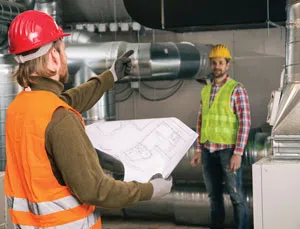Commercial buildings across the United States have a common problem: They seldom perform at design level. Optimum level provides the most comfortable and safe indoor environment for the occupants while balancing operation and maintenance costs for the owners.
Retro Commissioning (commissioning existing buildings) is a systematic process that helps solve this problem by allowing a building’s hvac system and integrated building controls to operate at peak performance. Retro Commissioning (Rcx) building systems can provide significant benefits such as improving occupant comfort, reducing energy cost, improving Indoor Air Quality (IAQ), enhancing building operations, and extending equipment life.
The National Environmental Balancing Bureau (NEBB) defines Rcx, as the systematic process by which the building owner ensures that the building and systems are optimized to perform interactively to meet the current operational needs as closely as possible.
The primary goal of Rcx is to determine the current requirements of the building and adjust the way the building’s systems are operated to match these requirements as closely as possible. With Rcx, the goal is not always to achieve 100% perfection. Existing facilities may not have the proper infrastructure in place — such as properly sized equipment, ductwork, piping, and electrical service — to reach a 100% perfectly operating facility. In this case, the existing systems are adjusted to optimize the building’s performance and achieve the highest level possible.
Additionally, a financial analysis is performed to determine the feasibility and payback of making the necessary modifications to reach a 100% perfectly operating facility, or as close to 100% that is financially justifiable. Sometimes it is cost-prohibitive to attempt 100% in an existing facility; for example, 90% can be achievable, however the last 10% is sometimes too expensive to justify the cost.
Rcx activities focus primarily on low-cost/no-cost optimization strategies that offer the greatest possibility for energy savings. Generally, the more complicated the mechanical system, the greater potential exists to discover opportunities that will improve building performance and save energy. Facilities such as hospitals, universities, laboratories, schools, and military bases are usually excellent choices for Rcx. Additionally, facilities such as office buildings and hotels that have a central boiler/chiller system and Direct Digital Controls (DDC) also are good candidates.
Hvac systems present the greatest opportunity for performance improvement and energy/operational cost savings. Correcting deficiencies associated with air and water distribution systems and control strategies are at the top of the Rcx list.
Commissioning an existing building has been shown to be a key energy-management activity over the last decade, often resulting in energy savings of 10%, 20%, or sometimes 30% without significant capital investment (Energy Management Handbook, Fifth Edition; 2005, page 679).
It is documented through the Building Owners & Managers Association (BOMA), that the average burdened cost-per employee in a Class A office building is just over $330 per square foot. Comparing employee cost with typical operating costs between $1.50 to $3.50 per square feet for lighting, hvac systems, and utilities shows that employees cost about 100 times the cost of building utilities.
When building occupants are uncomfortable, significant time, energy, and money is spent dealing with the complaints. Building managers have facility personnel chase down calls for areas that are either too warm or too cold. Often a quick fix is performed by treating the symptom instead of getting to the root cause of the problem. A business- as-usual routine of sending someone over to adjust a valve or damper for immediate relief only spills the problem over into another area, which is affected and soon spurs another work order.
Retro Commissioning is a holistic approach to discovering the deficiencies that exist in a facility’s hvac and control system. This approach also is extended out to the building envelope, which often is a significant contributor to comfort problems and energy waste. Envelope problems such as leaking windows, inadequate insulation in roof and wall connections, and unsealed penetrations in walls and slabs are typical and have a direct impact on the performance of hvac systems.
These problems are common. In a study of 60 new buildings by Lawrence Berkeley National Laboratory, it was determined that:
- 50% suffer control problems;
- 40% suffer hvac problems;
- 15% have missing equipment;
- 25% have facility management systems/economizers/drives that don't function;
- 60% of insurance claims are related to hvac problems;
- the #1 source of complaints is related to hvac problems.
In addition to the older, existing building market, some of the best candidates for Rcx are new buildings that were not commissioned and have had problems with the hvac system after being turned over and occupied.
Rcx is a management tool that building owners and managers can implement to help solve the challenges of assuring a safe and comfortable indoor environment for the building occupants, with the least cost of operating and maintaining the facility.

